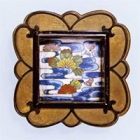Japanese Gallery (Honkan) Room 14
April 12, 2016 (Tue) - June 5, 2016 (Sun)
Cloisonné, or shippo in Japanese, is a technique in which colorful glazes are baked onto a metal object, creating a glass-like layer on its surface. This technique was used since antiquity in Western Asia, China, and Europe. Early examples in Japan include 7th century ornaments excavated from the Kegoshizuka burial mound (Asukamura, Nara prefecture) and 8th century objects from the Shosoin Repository of Imperial Treasures.
A certain Buddhist sutra explains how the Buddhist paradise is ornamented with seven varieties of “treasures” including gold, silver, jewels, and coral. These seven treasures are called shippo, from which the Japanese term for cloisonné is derived probably because the brilliant appearance of cloisonné was likened to these treasures.
Although this technique continued to be used in Europe and China, with foreign cloisonné works being brought into Japan during the Muromachi period (1392–1573), local use of this technique had ceased. With the development of new materials, subjects, and techniques in the decorative arts of the Edo period (1603–1868), shippo was revived and saw use in ornamented sliding door handles and nailhead covers, sword fittings, calligraphy tools, and other works with designs embodying Japanese aesthetics. This technique, however, fell into disuse once again.
Once Japan became a “modern” state and joined the international community in the late 19th century, it became committed to showing to the world the high level of its traditional decorative arts, submitting works to international expositions and exporting them for sale. Under these circumstances, Japanese cloisonné was revived and reached an unprecedented level both in terms of technique and artistic expression as demonstrated by, first and foremost, Kaji Tsunekichi (1803–83) and the “Owari shippo” style he created. The cloisonné works of other masters such as Namikawa Yasuyuki (1845–1927) were presented on the world stage and greeted with praise and admiration.
This exhibition introduces the beauty of Japanese cloisonné, featuring reproductions of works from the Shosoin Repository, colorfully ornamented sliding door handles and nailhead covers from the Edo period, as well as artworks of the Meiji era.
19th century cloisonné works of the Qing dynasty are being displayed in Room 5 of the Toyokan (Asian Gallery) until Sunday, July 3. Visitors are encouraged to view these two exhibitions in combination.

